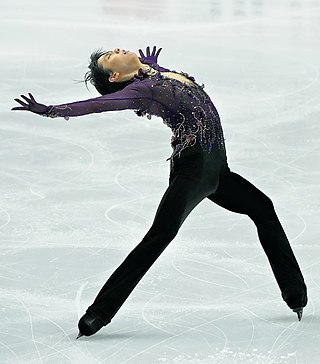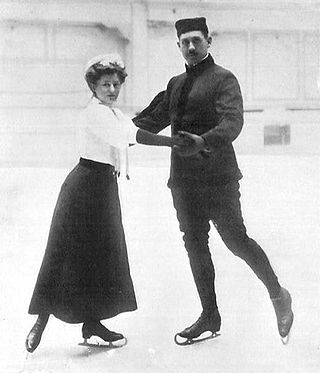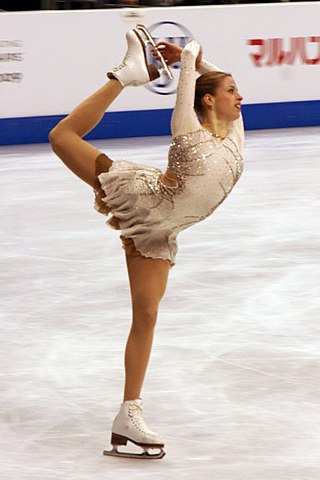
Figure skating is a sport in which individuals, pairs, or groups perform on figure skates on ice. It was the first winter sport to be included in the Olympic Games, with its introduction occurring at the 1908 Olympics in London. The Olympic disciplines are men's singles, women's singles, pair skating, and ice dance; the four individual disciplines are also combined into a team event, which was first included in the Winter Olympics in 2014. The non-Olympic disciplines include synchronized skating, Theater on Ice, and four skating. From intermediate through senior-level competition, skaters generally perform two programs, which, depending on the discipline, may include spins, jumps, moves in the field, lifts, throw jumps, death spirals, and other elements or moves.

The World Figure Skating Championships, commonly referred to as "Worlds", are an annual figure skating competition sanctioned by the International Skating Union. Medals are awarded in men's singles, women's singles, pair skating, and ice dance. Generally held in March, the World Championships are considered to be the most prestigious of the ISU Figure Skating Championships. With the exception of the Olympic title, a world title is considered to be the highest competitive achievement in figure skating.

Florence Madeline "Madge" Syers was a British figure skater. She became the first woman to compete at the World Figure Skating Championships in 1902 by entering what was previously an all-male event and won the silver medal, which prompted the International Skating Union (ISU) to create a separate ladies' championship. Syers was the winner of the first two ladies' events in 1906 and 1907 and went on to become the Olympic champion at the 1908 Olympics, the first Olympic Games to include figure skating. She also competed as a pairs skater with her husband Edgar Syers, winning the bronze medal at the 1908 Olympics.
The figure skating events at the 1992 Winter Olympic Games were held at the Halle Olympique located next to the Théâtre des Cérémonies, two kilometres southwest of downtown Albertville.

Figure skating was first contested in the Olympic Games at the 1908 Summer Olympics. Since 1924, the sport has been a part of the Winter Olympic Games.

Pair skating is a figure skating discipline defined by the International Skating Union (ISU) as "the skating of two persons in unison who perform their movements in such harmony with each other as to give the impression of genuine Pair Skating as compared with independent Single Skating". The ISU also states that a pairs team consists of "one Woman and one Man". Pair skating, along with men's and women's single skating, has been an Olympic discipline since figure skating, the oldest Winter Olympic sport, was introduced at the 1908 Summer Olympics in London. The ISU World Figure Skating Championships introduced pair skating in 1908.
The men's singles was one of four events in figure skating at the 1908 Summer Olympics. Each nation could enter up to 3 skaters. Sweden's Ulrich Salchow, who had won several World Figure Skating Championships, easily won the gold medal after his main rival, Russia's Nikolai Panin, withdrew either in protest over what he considered unfair judging or due to illness.
The men's special figures was one of four events in figure skating at the 1908 Summer Olympics. Each nation could enter up to 3 skaters. Gold medalist Nikolai Panin's real name was Nikolai Kolomenkin, but he competed under the pseudonym "Panin".
The mixed pairs was one of four events in figure skating at the 1908 Summer Olympics. Each nation could enter up to 3 pairs. Twelve years later, silver medalist Phyllis Johnson would capture a bronze medal with a new partner at the 1920 Olympics.
The men's 10 metre platform, also known as the high diving competition, was one of two diving events on the diving at the 1908 Summer Olympics programme, along with the men's 3 metre springboard. The competition was held from Monday 20 to Friday 24 July 1908. Twenty-four divers from six nations competed. Each nation could enter up to 12 divers.
The men's 3 metre springboard, also known as the fancy diving competition, was one of two diving events on the Diving at the 1908 Summer Olympics programme, along with the men's 10 metre platform. The competition was held on Tuesday 14 and Saturday 18 July 1908. Twenty-three divers from eight nations competed. Each nation could enter up to 12 divers.
The ISU Judging System or the International Judging System (IJS), occasionally referred to as the Code of Points (COP) system, is the scoring system that has been used since 2004 to judge the figure skating disciplines of men's and ladies' singles, pair skating, ice dance, and synchronized skating. It was designed and implemented by the International Skating Union (ISU), the ruling body of the sport.
The following is a glossary of figure skating terms, sorted alphabetically.

Single skating is a discipline of figure skating in which male and female skaters compete individually. Men's singles and women's singles are governed by the International Skating Union (ISU). Figure skating is the oldest winter sport contested at the Olympics, with men's and women's single skating appearing as two of the four figure skating events at the London Games in 1908.
The 6.0 system of judging figure skating was developed during the early days of the sport, when early international competitions consisted of only compulsory figures. Skaters performed each figure three times on each foot, for a total of six, which as writer Ellyn Kestnbaum states, "gave rise to the system of awarding marks based on a standard of 6.0 as perfection". It was used in competitive figure skating until 2004, when it was replaced by the ISU Judging System in international competitions, as a result of the 2002 Winter Olympics figure skating scandal. British ice dancers Jayne Torvill and Christopher Dean earned the most overall 6.0s in ice dance, Midori Ito from Japan has the most 6.0s in single skating, and Irina Rodnina from Russia, with two different partners, has the most 6.0s in pair skating.
The men's single skating competition of the 1960 Winter Olympics was held at the Blyth Arena in Squaw Valley, California, United States. The compulsory figures section took place on Wednesday 24 February 1960 with the free skating section concluding the event two days later. Each judge ranked each skater by Ordinal Placement from first to last place. If a skater was ranked first by a majority of the judges, that skater was placed first overall, this process was repeated for each place. If more than one skater had a majority ranking for the same position then a series of tiebreaks were in place, indicated in order in the result section.
The women's single skating competition of the 1960 Winter Olympics was held at the Blyth Arena in Squaw Valley, California, United States. The compulsory figures section took place on Sunday 21 February 1960 with the free skating section concluding the event two days later. Each judge ranked each skater by Ordinal Placement from first to last place. If a skater was ranked first by a majority of the judges, that skater was placed first overall, this process was repeated for each place. If more than one skater had a majority ranking for the same position then a series of tiebreaks were in place, indicated in order in the result section.
The pair skating competition of the 1960 Winter Olympics was held at the Blyth Arena in Squaw Valley, California, United States. The event took place on Friday 19 February 1960. Each judge ranked the skaters by Ordinal Placement from first to last place. If a skater was ranked first by a majority of the judges, that skater was placed first overall; this process was repeated for each place. If more than one skater had a majority ranking for the same position, then a series of tiebreaks were in place, indicated in order in the Results section below.
The 2019–20 Grand Prix of Figure Skating Final and ISU Junior Grand Prix Final was held from December 5–8, 2019 at the Torino Palavela in Turin, Italy. The combined event was the culmination of two international series — the Grand Prix of Figure Skating and the Junior Grand Prix. Medals were awarded in the disciplines of men's singles, ladies' singles, pair skating, and ice dance on the senior and junior levels.






